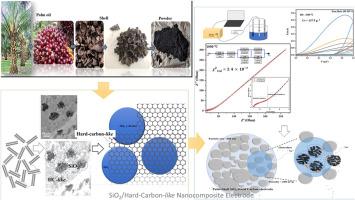Palm oil shell-derived SiO2/hard-carbon-like nanocomposites for a potential application as dual carbon battery electrode
IF 5.8
2区 生物学
Q1 AGRICULTURAL ENGINEERING
引用次数: 0
Abstract
Palm oil shell waste was converted into SiO2/hard-carbon-like (HC-like) nanocomposites for a dual carbon Na-ion battery through a one-step air pyrolysis process. Heating the shells for 5 h at 400–1000 °C (5 °C min−1) generated hierarchical porosity with BET surface areas of 570–650 m2 g−1. X-ray diffraction and elemental mapping confirmed amorphous HC-like carbon intermixed with SiO2 nanodomains, while XPS and Raman spectroscopy (D , G ; weak 2D ) tracked temperature-dependent bond ordering. The electrode prepared from biomass pyrolyzed at 700 °C exhibited the highest specific capacitance (137.0 F g−1), whereas the highest ion diffusion coefficient was observed for the 550 °C sample (5 10−13 cm2 s−1). Electrochemical performance indicated rapid Na+ ion transport at 550 °C and 700 °C, suggesting these as optimal processing temperatures to balance material structure and electrode performance. This study demonstrates that palm oil shells are a sustainable and high-performance precursor for sodium-ion battery anodes.

棕榈油壳衍生SiO2/类硬碳纳米复合材料作为双碳电池电极的潜在应用
通过一步空气热解工艺,将棕榈油壳废弃物转化为用于双碳钠离子电池的SiO2/类硬碳纳米复合材料。在400-1000°C(5°C min - 1)下加热5小时,产生分层孔隙,BET表面积为570-650 m2 g - 1。x射线衍射和元素映射证实了非晶态类hc碳与SiO2纳米畴混合,而XPS和拉曼光谱(D≈1350cm−1,G≈1590cm−1,弱2D≈2700cm−1)追踪了温度相关的键序。由700℃热解的生物质制备的电极具有最高的比电容(137.0 F g−1),而550℃样品的离子扩散系数最高(5 × 10−13 cm2 s−1)。电化学性能表明,在550°C和700°C时Na+离子快速迁移,这表明这是平衡材料结构和电极性能的最佳加工温度。这项研究表明,棕榈油壳是一种可持续和高性能的钠离子电池阳极前驱体。
本文章由计算机程序翻译,如有差异,请以英文原文为准。
求助全文
约1分钟内获得全文
求助全文
来源期刊

Biomass & Bioenergy
工程技术-能源与燃料
CiteScore
11.50
自引率
3.30%
发文量
258
审稿时长
60 days
期刊介绍:
Biomass & Bioenergy is an international journal publishing original research papers and short communications, review articles and case studies on biological resources, chemical and biological processes, and biomass products for new renewable sources of energy and materials.
The scope of the journal extends to the environmental, management and economic aspects of biomass and bioenergy.
Key areas covered by the journal:
• Biomass: sources, energy crop production processes, genetic improvements, composition. Please note that research on these biomass subjects must be linked directly to bioenergy generation.
• Biological Residues: residues/rests from agricultural production, forestry and plantations (palm, sugar etc), processing industries, and municipal sources (MSW). Papers on the use of biomass residues through innovative processes/technological novelty and/or consideration of feedstock/system sustainability (or unsustainability) are welcomed. However waste treatment processes and pollution control or mitigation which are only tangentially related to bioenergy are not in the scope of the journal, as they are more suited to publications in the environmental arena. Papers that describe conventional waste streams (ie well described in existing literature) that do not empirically address ''new'' added value from the process are not suitable for submission to the journal.
• Bioenergy Processes: fermentations, thermochemical conversions, liquid and gaseous fuels, and petrochemical substitutes
• Bioenergy Utilization: direct combustion, gasification, electricity production, chemical processes, and by-product remediation
• Biomass and the Environment: carbon cycle, the net energy efficiency of bioenergy systems, assessment of sustainability, and biodiversity issues.
 求助内容:
求助内容: 应助结果提醒方式:
应助结果提醒方式:


